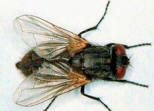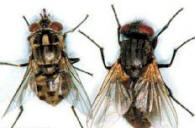
- Adult: The house fly is 5 to 7 mm long, with the female usually larger than the male. Its head has reddish-eyes and sponging mouthparts. The thorax bears four narrow black stripes and there is a sharp upward bend in the fourth longitudinal wing vein. The abdomen is gray or yellowish with dark midline and irregular dark markings on the sides.
- The underside of the male is yellowish. The sexes can be readily separated by noting the space between the eyes, which in females is almost twice as broad as in males.
- The house fly is often confused with the stable fly, Stomoxys calcitrans (Linnaeus), and the false stable fly, Muscina stabulans (Germar). All three are in the same family.
- The flies are inactive at night, with ceilings, beams
and overhead wires within buildings, trees, and shrubs, various kinds of
 outdoor wires, and grasses reported as overnight resting sites.
outdoor wires, and grasses reported as overnight resting sites. - In poultry ranches, the night time, outdoor aggregations of flies are found mainly in the branches, and shrubs, whereas almost all of the indoor populations are generally aggregated in the ceiling area of poultry houses.
- The house fly has a complete metamorphosis with distinct egg, larva or maggot, pupal and adult stages. The house fly over-winters in either the larval or pupal stage under manure piles or in other protected locations.
- Warm summer conditions are generally optimum for the development of the house fly, and it can complete its life cycle in as little as seven to ten days and as many as 10 to 12 generations may occur in one summer.
- Egg: The white egg, about 1.2 mm in length, is laid singly but eggs are piled in small groups. Each female fly can lay up to 500 eggs in several batches of 75 to 150 eggs over a three to four day period. The number of eggs produced is a function of female size which, itself, is principally a result of larval nutrition.
- Larva: The mature larva is 3 to 9 mm long, typical creamy whitish in colour, cylindrical but tapering toward the head. The head contains one pair of dark hooks. The posterior spiracles are slightly raised and the spiracular openings are sinuous slits which are completely surrounded by an oval black border. The legless maggot emerges from the egg in warm weather within eight to 20 hours, and immediately feeds on and develops in the material in which the egg was laid. The full-grown maggot has a greasy, cream-colored appearance and is 8 to 12 mm long. The larva goes through three instars. When the maggot is full-grown, it can crawl up to 50 feet to a dried, cool place near breeding material and transform to the pupal stage. High-moisture manure favors the survival of the house fly larva.
- Pupa: The pupa is dark brown and 8 mm long. The pupal stage is passed in a pupal case formed from the last larval skin which varies in colour from yellow, red, brown, to black as the pupa ages. The emerging fly escapes from the pupal case through the use of an alternately swelling and shrinking sac, called the ptilinum, on the front of its head which it uses like a pneumatic hammer to break through the case.
- Adults usually live 15 to 25 days. It has been stated that a pair of flies beginning operations in April may be progenitors, if all were to live, of 191,010,000,000,000,000,000, flies by August.
- Adults suck liquids containing sweet or decaying substances. Larvae feed on moist food rich in organic matter. Although they are attracted to a variety of food material, house flies have mouthparts which allow them to ingest only liquid materials. Solid materials are liquified by means of regurgitated saliva.
- The flies are inactive at night, with ceilings, beams and overhead wires within buildings, trees, and shrubs, various kinds of outdoor wires, and grasses reported as overnight resting sites. In poultry ranches, the nighttime, outdoor aggregations of flies are found mainly in the branches, and shrubs, whereas almost all of the indoor populations generally aggregated in the ceiling area of poultry houses
- More than 100 pathogens associated with the house fly may cause
disease in humans and animals, including typhoid,
 cholera, bacillary
dysentery, tuberculosis, anthrax ophthalmia and infantile diarrhea, as
well as parasitic worms. Pathogenic organisms are picked up by flies
from garbage, sewage and other sources of filth, and then transferred on
their mouthparts, through their vomitus, feces and contaminated external
body parts to human and animal food.
cholera, bacillary
dysentery, tuberculosis, anthrax ophthalmia and infantile diarrhea, as
well as parasitic worms. Pathogenic organisms are picked up by flies
from garbage, sewage and other sources of filth, and then transferred on
their mouthparts, through their vomitus, feces and contaminated external
body parts to human and animal food. - The most important damage related with this insect is the annoyance and the indirect damage produced by the potential transmission of more than 100 pathogens associated with this fly.
- House flies are monitored with baited traps, sticky ribbons, or spot cards on livestock facilities. Spot cards are white index cards attached to fly resting surface. A minimum of five cards should be placed in each animal facility and left in place for seven days. A count of 100 or more faecal or vomit spots per card per week indicates a high level of fly activity and a need for control.
- The more commonly used control measures for house flies are sanitation, use of traps, and insecticides, but in some instances integrated fly control has been implemented. The use of biological control in fly management is still at a relatively early stage.
- Good sanitation is the basic step in any fly management program. Food and materials on which the flies can lay eggs must be removed, destroyed as a breeding medium, or isolated from the egg-laying adult. Since the house fly can complete its life cycle in as little as seven days, removal of wet manure at least twice a week is necessary to break the breeding cycle. Wet straw should not be allowed to pile up in or near buildings. Since straw is one of the best fly breeding materials, it is not recommended as bedding. Spilled feed should not be allowed to accumulate but should be cleaned up two times a week. Ordinarily, fly control from 1 to 2 km around a municipality prevents house fly infestations.
- Killing adult flies may reduce the infestation, but elimination of breeding areas is necessary for good management. Garbage cans and dumpsters should have tight-fitting lids and be cleaned regularly. Dry garbage and trash should be placed in plastic garbage bags and sealed up. All garbage receptacles should be located as far from building entrances as possible.
- For control at waste disposal sites, refuse should be deposited onto the same area as inorganic wastes to deteriorate the capacity of breeding resources, or the disposed refuse should be covered with soil or other inorganic wastes (15 cm thickness) on every weekend or every other weekend.
- The house fly has many natural enemies and among the more important in poultry facilities are the wasps (Hymenoptera: Pteromalidae) Muscidiforax raptor and Spalangia cameroni. Leaving a layer of old manure in the pits when manure is removed might enhance or stabilize the suppression of the house flies densities by parasitoids and predators. Periodic release of parasitoids during winter and spring, and following manure removal, might effectively suppress densities in poultry facilities
- Biological Control: With the increasing incidence of insecticide
resistant house fly populations, rising costs of
 insecticides and a
growing public concern about actual or potential problems associated
with insecticides, interest in alternative house fly control strategies
has increased.
insecticides and a
growing public concern about actual or potential problems associated
with insecticides, interest in alternative house fly control strategies
has increased. - Traps: Fly traps may be useful in some fly control programs if enough traps are used, if they are placed correctly, and if they are used both indoors and outdoors. House flies are attracted to white surfaces and to bait that give off odours. Indoors, ultraviolet light traps collect the flies inside an inverted cone or kill them with an electrocuting grid. One trap should be placed for every 30 feet of wall inside buildings, but not placed over or within five feet of food preparation areas. Recommended placement areas outdoors include near building entrances, in alleyways, beneath trees, and around animal sleeping areas and manure piles. Openings to buildings should be tightly screened with standard window screen, thereby denying entrance to flies.